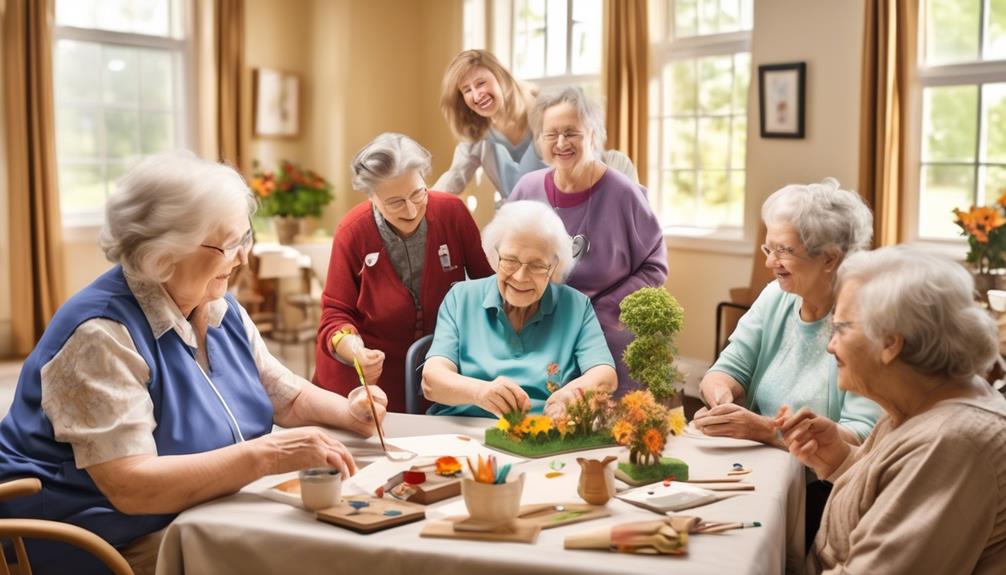To practice active listening as a caregiver, focus on noticing non-verbal cues like facial expressions, gestures, and eye contact to understand emotions better. Stay present by giving your full attention, maintaining eye contact, and nodding to show engagement. Let the speaker share without interruption and ask clarifying questions such as “Can you tell me more?” to deepen understanding. Embracing these techniques helps build trust and promotes open communication—continue exploring to master these essential skills.
Key Takeaways
- Maintain eye contact, nod, and lean forward to show engagement and presence during conversations.
- Focus entirely on the speaker, avoiding distractions and giving full attention to understand their emotional cues.
- Use open-ended questions like “Can you tell me more?” to encourage sharing and clarify feelings.
- Validate the speaker’s emotions by acknowledging their feelings, such as “It sounds like you’re upset.”
- Reflect and summarize what you’ve heard to demonstrate understanding and foster trust.

Ever wondered how some conversations feel more meaningful and productive? It’s often because the person listening isn’t just hearing words—they’re truly engaging with the speaker. As a caregiver, mastering active listening techniques can make a huge difference in your interactions. One key component is paying close attention to non verbal cues. These include facial expressions, gestures, posture, and eye contact, which often reveal more than words ever could. When you notice someone’s furrowed brow or clenched fists, you instantly get a clearer picture of their feelings. Responding to these cues with genuine empathetic responses shows that you understand and care about what they’re experiencing. For example, if a loved one looks distressed and avoids eye contact, acknowledging that with a gentle, “It seems like you’re upset,” can validate their feelings and encourage them to open up further. Incorporating emotional cues into your listening helps you better interpret underlying messages and respond more compassionately.
Empathetic responses are the heart of active listening. They’re not just about hearing the words but about truly understanding the emotions behind them. When you hear someone say they’re overwhelmed, instead of offering solutions immediately, you might say, “That sounds really tough. I can see it’s weighing on you.” This kind of response demonstrates that you’re tuned into their emotional state, fostering trust and openness. It’s essential to stay present during conversations, avoiding distractions and giving your full attention. This shows the speaker that they matter and that their feelings are important. Maintaining eye contact, nodding affirmatively, and leaning slightly forward all serve as non verbal cues that reinforce your engagement.
Practicing active listening also involves giving space for the other person to speak without interruption. It means resisting the urge to jump in with advice or judgments too quickly. Instead, ask clarifying questions like, “Can you tell me more about what happened?” or “How are you feeling right now?” These questions demonstrate genuine interest and help deepen understanding. As you respond empathetically and observe non verbal cues, you create a safe environment where your loved ones feel heard and valued. This not only strengthens your relationship but also encourages them to share more openly in the future. The power of active listening lies in your ability to connect on a human level, showing that you’re truly present and invested in their well-being. Ultimately, these skills foster better communication, deeper trust, and a more compassionate caregiving relationship.
Frequently Asked Questions
How Can I Improve My Active Listening Skills Quickly?
To improve your active listening skills quickly, focus on developing empathy by fully engaging in conversations and showing genuine interest. Practice clarifying questions to guarantee understanding and encourage open communication. Avoid interrupting and give your full attention to the speaker. Summarize what they say to confirm comprehension. With consistent effort, these techniques will boost your listening skills, helping you connect better and respond more thoughtfully in caregiving situations.
What Are Common Barriers to Active Listening in Caregiving?
You might face barriers like distractions or impatience, which hinder empathy development and your ability to pick up non-verbal cues. When your mind wanders or you rush to respond, you miss subtle signals that reveal feelings. To improve, stay present, minimize interruptions, and focus on body language and tone. By consciously practicing patience and observing non-verbal cues, you strengthen your listening skills and foster better understanding with those you care for.
How Do I Respond When a Patient Is Unresponsive?
Have you ever wondered how to connect when someone’s unresponsive? When a patient isn’t replying, focus on their emotional cues and nonverbal signals—like breathing or facial expressions. You can respond softly, maintain eye contact, and use gentle gestures to show you’re present. Sometimes, your calm presence and attentive body language can help them feel safe enough to communicate, even without words. Wouldn’t you want someone to do the same for you?
Can Active Listening Help Prevent Caregiver Burnout?
Yes, active listening can help prevent caregiver burnout by enhancing your emotional awareness and patience development. When you actively listen, you better understand your patients’ needs and feelings, reducing frustration and emotional exhaustion. This practice also fosters a sense of connection and empathy, making your caregiving experience more rewarding. Over time, this reduces stress and prevents burnout, helping you stay resilient and committed to providing compassionate care.
What Tools or Apps Support Effective Active Listening?
They say, “A good listener is a good communicator,” and digital tools can help you master this. Communication apps like WhatsApp, Slack, or Zoom enable real-time, focused conversations. Additionally, apps like Otter.ai transcribe your calls, helping you capture details accurately. These digital tools support effective active listening, making it easier to understand your loved ones and connect deeply—remember, technology is only as good as the effort you put into it.
Conclusion
So, next time your loved one starts to talk, remember: don’t just nod and pretend you’re paying attention. Practice active listening, because nothing says “I care” like genuinely hearing them out—without multitasking or checking your phone. Who knew that truly listening could be the secret sauce to better relationships? So go ahead, give it a try. After all, if you’re going to pretend to care, might as well do it well!








